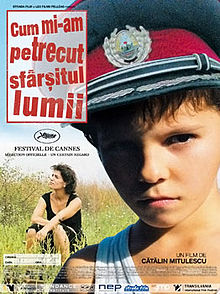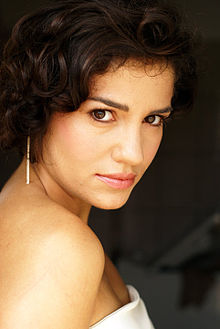 This movie is a sketch of the life of 17-year-old Eva living in Romania’s capital Bucharest in 1989. In 1989, the General Secretary of the Communist Party in Romania, Nicolae Ceauşescu, was executed and this was the year the communist dictatorship fell. In this movie, Eva seems to be rebellious, expressionless, unsociable, irresponsible, and random (however, she looks pretty and shows a little smile when she talks with her boyfriend); even though she is going out with Alexandru, the son of an important man in the socialist administration, she shows interest in Andrei, whose parents are missing on the charge of the assassination attempt of Nicolae Ceauşescu, and the two plan to cross the Danube River to escape to Yugoslavia. But partway through, Eva says “I quit,” stops crossing of the river, and returns to Bucharest alone; her parents are angry and they ask Eva to keep a good relationship with Alexandru for the sake of the safety of their family. Eva is captivated with a cheap condominium (or it may be a high-end condo by Romanian standards) that Alexandru recently bought. In the end, an intimate relationship between the two somehow develops, and Eva returns home and declares triumphantly, “We are engaged!!” but immediately after, a bloody revolution erupts; the adults, who seemed until then to be gloomy and obedient to authority, suddenly and joyfully begin destructive activity. This movie ends after briefly depicting Alexandru’s family slipping from the upper class after the bloody revolution, Andrei safely arriving in Italy via Yugoslavia, and Eva triumphantly pursuing a career as a crew member on an international passenger ship.
This movie is a sketch of the life of 17-year-old Eva living in Romania’s capital Bucharest in 1989. In 1989, the General Secretary of the Communist Party in Romania, Nicolae Ceauşescu, was executed and this was the year the communist dictatorship fell. In this movie, Eva seems to be rebellious, expressionless, unsociable, irresponsible, and random (however, she looks pretty and shows a little smile when she talks with her boyfriend); even though she is going out with Alexandru, the son of an important man in the socialist administration, she shows interest in Andrei, whose parents are missing on the charge of the assassination attempt of Nicolae Ceauşescu, and the two plan to cross the Danube River to escape to Yugoslavia. But partway through, Eva says “I quit,” stops crossing of the river, and returns to Bucharest alone; her parents are angry and they ask Eva to keep a good relationship with Alexandru for the sake of the safety of their family. Eva is captivated with a cheap condominium (or it may be a high-end condo by Romanian standards) that Alexandru recently bought. In the end, an intimate relationship between the two somehow develops, and Eva returns home and declares triumphantly, “We are engaged!!” but immediately after, a bloody revolution erupts; the adults, who seemed until then to be gloomy and obedient to authority, suddenly and joyfully begin destructive activity. This movie ends after briefly depicting Alexandru’s family slipping from the upper class after the bloody revolution, Andrei safely arriving in Italy via Yugoslavia, and Eva triumphantly pursuing a career as a crew member on an international passenger ship.
Eva is expressionless and arrogant from the start to finish and her inner state isn’t depicted at all. She goes back and forth between Alexandru—who symbolizes in the movie the center of political power—and Andrei—who symbolizes anti-establishment. Despite their political differences, she is attracted to both of them with the fickle feelings of a teenager. Romania, an underdeveloped satellite country of the Soviet Union, is in a desolate state of affairs and even the capital Bucharest is in bad shape; we don’t know what the parents do, but they always look gloomy, tired, and uninterested in their children. I don’t think they are poor, but it seems that the home is also in a dismal state and their meals are just soup and bread. There is no discussion of politics because the adults are afraid to get involved with politics. This depiction of desolate everyday life aptly shows the true nature of the stagnation that resulted from the socialist dictatorship in Romania and no further words of explanation are needed.
 The Romanian film world first showed signs of new activity in the late 1980s and it started getting attention from film festivals, primarily the Cannes Film Festival, in the 2000s. These movies focused on the themes of the transition from a socialist country to one with a free economy or criticisms of the Ceauşescu regime, and many seemed to have an unfinished, minimalistic, documentary feel. There is a divide on whether to call this “fresh” or “amateurism,” but after watching movies from Poland, the Czech Republic, and Hungary that proudly demonstrate sophisticated techniques, I have a feeling that Romanian movies have a long way to go. Perhaps because Western European countries want to support Romania, Romanian movies briefly gained praise at Cannes, and Dorotheea Petre who played Eva in this movie even won the Best Actress Award at Cannes. This movie’s story is unrefined; since winter and summer are repeated many times, it feels like many years pass in the story, but it is only one year. This movie doesn’t seem to care about these inaccuracies. In addition, Dorotheea Petre who played Eva looks like she is in her 30s and doesn’t at all resemble the actress who played her mother, who is dressed to look younger; the two look as if they are sisters or friends. Both actresses certainly are quite beautiful, but that is not enough. There is a feeling somehow that this movie was made without attention to details, in contrast to the many directors in the world that really pay attention to detail. I wonder where Romanian movies will go from here.
The Romanian film world first showed signs of new activity in the late 1980s and it started getting attention from film festivals, primarily the Cannes Film Festival, in the 2000s. These movies focused on the themes of the transition from a socialist country to one with a free economy or criticisms of the Ceauşescu regime, and many seemed to have an unfinished, minimalistic, documentary feel. There is a divide on whether to call this “fresh” or “amateurism,” but after watching movies from Poland, the Czech Republic, and Hungary that proudly demonstrate sophisticated techniques, I have a feeling that Romanian movies have a long way to go. Perhaps because Western European countries want to support Romania, Romanian movies briefly gained praise at Cannes, and Dorotheea Petre who played Eva in this movie even won the Best Actress Award at Cannes. This movie’s story is unrefined; since winter and summer are repeated many times, it feels like many years pass in the story, but it is only one year. This movie doesn’t seem to care about these inaccuracies. In addition, Dorotheea Petre who played Eva looks like she is in her 30s and doesn’t at all resemble the actress who played her mother, who is dressed to look younger; the two look as if they are sisters or friends. Both actresses certainly are quite beautiful, but that is not enough. There is a feeling somehow that this movie was made without attention to details, in contrast to the many directors in the world that really pay attention to detail. I wonder where Romanian movies will go from here.
1989 was the year that the Tiananmen Square Massacre happened and the grip of communism was strengthened in China, but it was also the year that the communist dictatorship in Eastern Europe was ended relatively peacefully. John Paul II from Poland was inaugurated as Pope in 1978 and, even though nobody thought that this was a step towards ending the Cold War, I think Pope John Paul II greatly contributed to the ending of the Cold War. Poles felt that there was something to believe in, a kind of spiritual hope. This led to the rise of charismatic yet pragmatic, labor-union chairman Lech Wełęsa. While he was trying to change the social and political direction of Poland with the word “Solidarity,” most people in the world watching Eastern Europe thought, “Oh no, something like the Hungarian Revolution or the Prague Spring might be repeated in Poland…” However, Wełęsa’s approach was different. He who would bend but not break to pressure carefully watched Moscow’s reaction in order to advance or retreat appropriately, advocated for nonviolence, and patiently and peacefully pushed for the democratization of Poland.
Hungary was similarly a “mature country.” This is because Hungary prided itself in being an advanced country like Austria. Mikhail Gorbachev’s administration of the Soviet Union began “perestroika” in 1985, which removed what was called the “Brezhnev Doctrine” that regulated the Eastern Bloc of the communist party countries; Hungary, taking advantage of this deregulation, opened the national border between Hungary and Austria in May of 1989. A non-communist regime was elected in Poland in June and a non-communist regime was established in Hungary in October.
Now that citizens from East Germany could cross the Hungary-Austria national border and flee to West Germany by way of Austria, the Berlin Wall had lost its purpose for existing. The Berlin Wall was destroyed on November 10. This encouraged many citizens in Czechoslovakia and Romania to demand democratization. On November 17, a bloodless revolution called the Velvet Revolution began in Czechoslovakia. However, a bloody revolution in Romania resulted in the execution of the dictator Nicolae Ceauşescu.
Nicolae Ceauşescu was the dictator of Romania for 22 years, from 1967 to 1989. At the beginning, he opposed the suppression of the Prague Spring by the Soviet Union and refused to send armed forces; declared a pro-Western Bloc attitude along with Yugoslavia; and became a member of IMF and GATT and conformed to Western Bloc economics. Romania was the only satellite country of the Soviet Union that established diplomatic relations with Israel, and it participated in the 1984 Los Angeles Olympics when all other Eastern Bloc countries boycotted it. Nicolae Ceauşescu gained a very favorable impression with the Western Bloc countries, and support from citizens was also high. Unfortunately, however, he seemed to have held a position of power for too long. He gradually began to turn Romania’s government structure in a direction that resembled the Workers’ Party of Korea in North Korea or the Chinese Communist Party.
The failure of Nicolae Ceauşescu’s economic policy was what decisively made him unpopular. Because Romania was popular with the Western Bloc countries, it was able to easily obtain funds from the Western Bloc, but this was a double-edged sword. Romania struggled with paying off this large sum of money that was loaned to them, causing the national economy to suffer and most Romanians to live in great poverty. Due to the food rationing system that was established in the country and the unreasonable exports that were given priority, Romanian citizens were without daily food or fuel for winter heating, and power outages became frequent. Such things are depicted in this movie.
In the “Arab Spring” of 2012, Twitter functioned as real-time communication and accelerated a revolution, while television played a big part in the “Revolutions of 1989” in Eastern Europe. Through television, Romanian citizens were able to know what happened in Hungary, Poland, Czechoslovakia, and East Germany. We can see this happening in Romania extensively in this movie.
